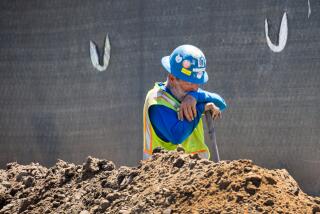
- Share via
If you looked at a temperature map this week — it doesn’t much matter which day it was — you would have seen bright red stretching from Baja California all the way to Canada’s Northwest Territories.
Sweltering heat enveloped the West Coast for an entire week in places more than a thousand miles apart, and set an all-time temperature record of 124 degrees in Palm Springs. Death Valley, home of the world’s hottest recorded temperature, was flirting with its own record as thermometers recorded a temperature of 128 degrees for multiple days in a row.
And all this comes barely a month after a previous heat wave sent temperatures in the Central Valley into the triple digits before summer had officially begun, prompting the question: what is causing all this extreme heat?
The direct source of almost all heat waves is a high-pressure system in the upper atmosphere, which has several effects. First, the high pressure suppresses cloud formation, meaning that the bright midsummer sun can rapidly heat the ground throughout the day. And second, this high pressure acts as a lid, preventing the hot air from rising through convection as it otherwise would.
Aggressive and impactful reporting on climate change, the environment, health and science.
This phenomenon is sometimes described as a “heat dome,” which although not a scientific term, does help illustrate how hot air can become trapped at the surface by the “dome” of high pressure above it. Sometimes, as is happening across the entire West Coast, the heat dome can become stuck in place due to interactions with nearby pressure systems, extending the heat wave and making it far more threatening to human health.
Of course, in the 21st century, every heat wave is also caused at least in part by climate change. Previously, the same clear skies that allow in sunlight would also make it easier for heat to escape at night in the form of infrared rays, leading to cooler overnight temperatures.
Now, the greenhouse gasses that humans have emitted over the last century act as a sort of second heat dome, except instead of blocking convection, they suppress radiation. Just as you would expect, the result is even higher temperatures as both of the main methods of heat transport in the atmosphere are impeded.
The increased danger of heat waves is not occurring equally in all regions — in the hot, dry conditions of the Southwestern U.S., heat wave intensity and frequency is increasing particularly rapidly. There is also an asymmetry between day and night: summer low temperatures have increased more than twice as fast as highs over the past 50 years. This pattern is particularly concerning because nighttime temperatures above 80 degrees are one of the best indicators of heatwave mortality, in large part because hot nights disrupt the natural cooling process during sleep.
The Jurupa Valley City Planning Commission has requested further study on a development that potentially threatens one of the oldest plants in the world.
Just as worrisome, heat waves seem to be becoming not only stronger but also more prolonged.
Scientists have proposed a number of causes for this phenomenon, including changes to the El Niño oscillation and decreases in the amount of heat being exported into the ocean surface. These longer heat waves increase the danger not just of heatstroke, but also of wildfires. A key indicator of extreme fire danger is when the temperature (in Celsius) is greater than the percentage of relative humidity — a threshold that was passed in Santa Ynez just as firefighters were fighting to contain the Lake fire on Monday afternoon.
Hot air — and especially hot, dry air — drives up wildfire risk because it can hold more moisture, increasing the amount of evaporation that can occur. When evaporative demand rises, many plants are unable to keep up as their tissue begins to dry. And as anyone who has built a campfire knows, dry wood lights much faster than wet, because the fire doesn’t need to spend its energy evaporating the water as steam.
Moreover, extended heat waves also add to the risk of even larger fires in the future. Trees, already stressed by drought, are pushed over the edge by multiple days of intense heat, which can lead to “hydraulic failure” when air bubbles form within the tree’s vascular tissue, ultimately killing it. When these massive die-offs occur, they create huge swathes of dead, flammable wood that are ready to ignite in the subsequent fire season.
Amid extreme heat, California officials adopted water-saving rules for cities — a decision that sparked debate about whether the measures go far enough.
Even as the current heatwave approaches its long-awaited end, we must do what we can to prepare for (and, as much as possible, postpone) a future with more events like it.
Extreme heat brings with it a diverse set of problems that require a constellation of solutions, but fortunately there are many groups that are stepping up: Los Angeles County has an interactive online map listing the hours of 171 cooling centers, the U.S. Forest Service oversaw record amounts of prescribed burning in California in the past year to clear out undergrowth and dead vegetation, and California’s climate bond (if passed) would allocate $450 million for extreme heat mitigation.
Less fortunately, even the best intentions are not always enough: for instance, the Forest Service was forced to postpone the Tanbark prescribed fire near Glendora several weeks ago as environmental conditions worsened. The climate bond was necessitated at least in part by the fact that nearly $3 billion in climate funding is likely to be cut from California’s budget because of deficits, and a report published in March suggested that the state would need to almost triple its emission reduction rate to meet the 2030 targets mandated by state law.
As the heat wave has made clear, there is a great deal of work to be done for society to adapt to climate change, and we are running out of time to do it.
Ned Kleiner is a scientist and catastrophe modeler at Verisk. He has a doctorate in atmospheric science from Harvard.









